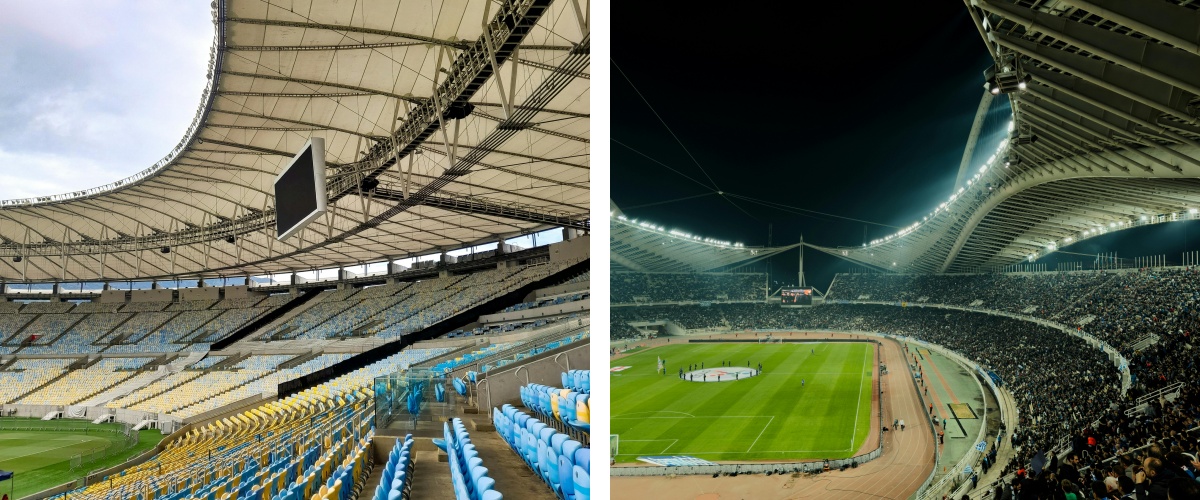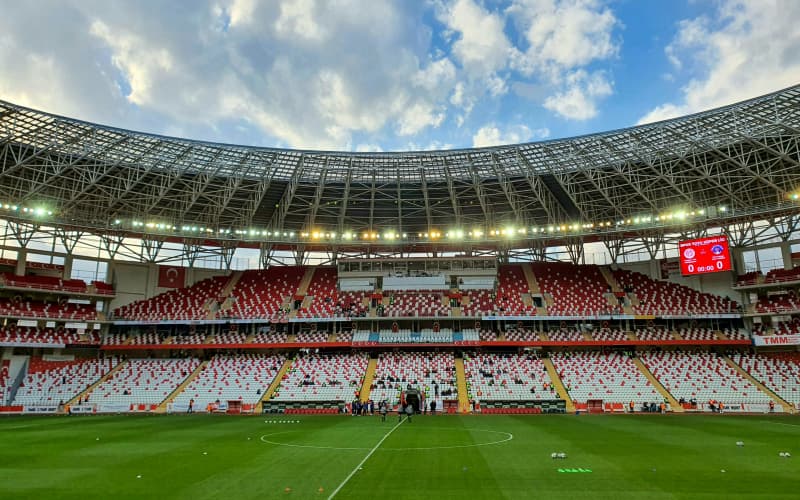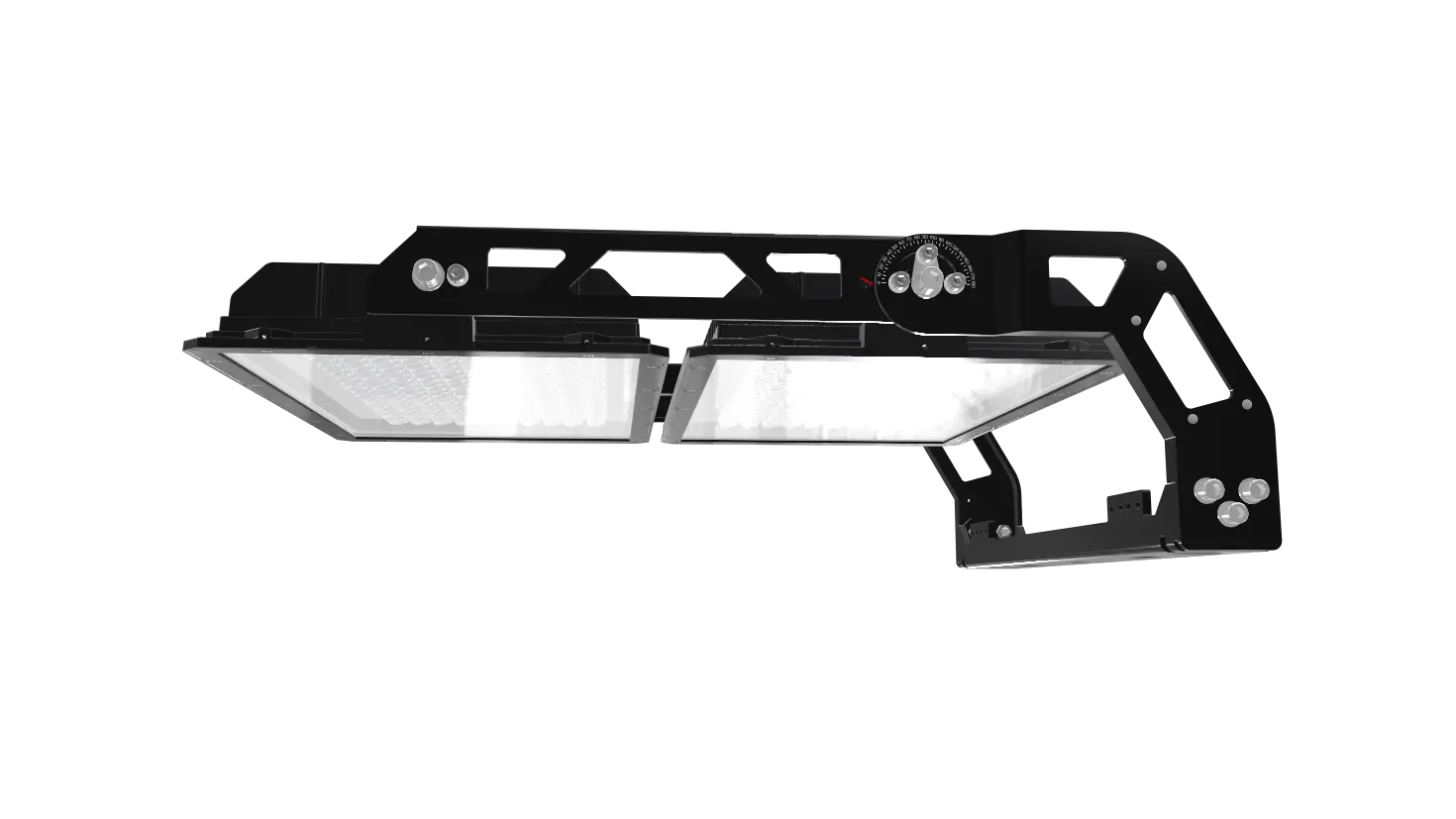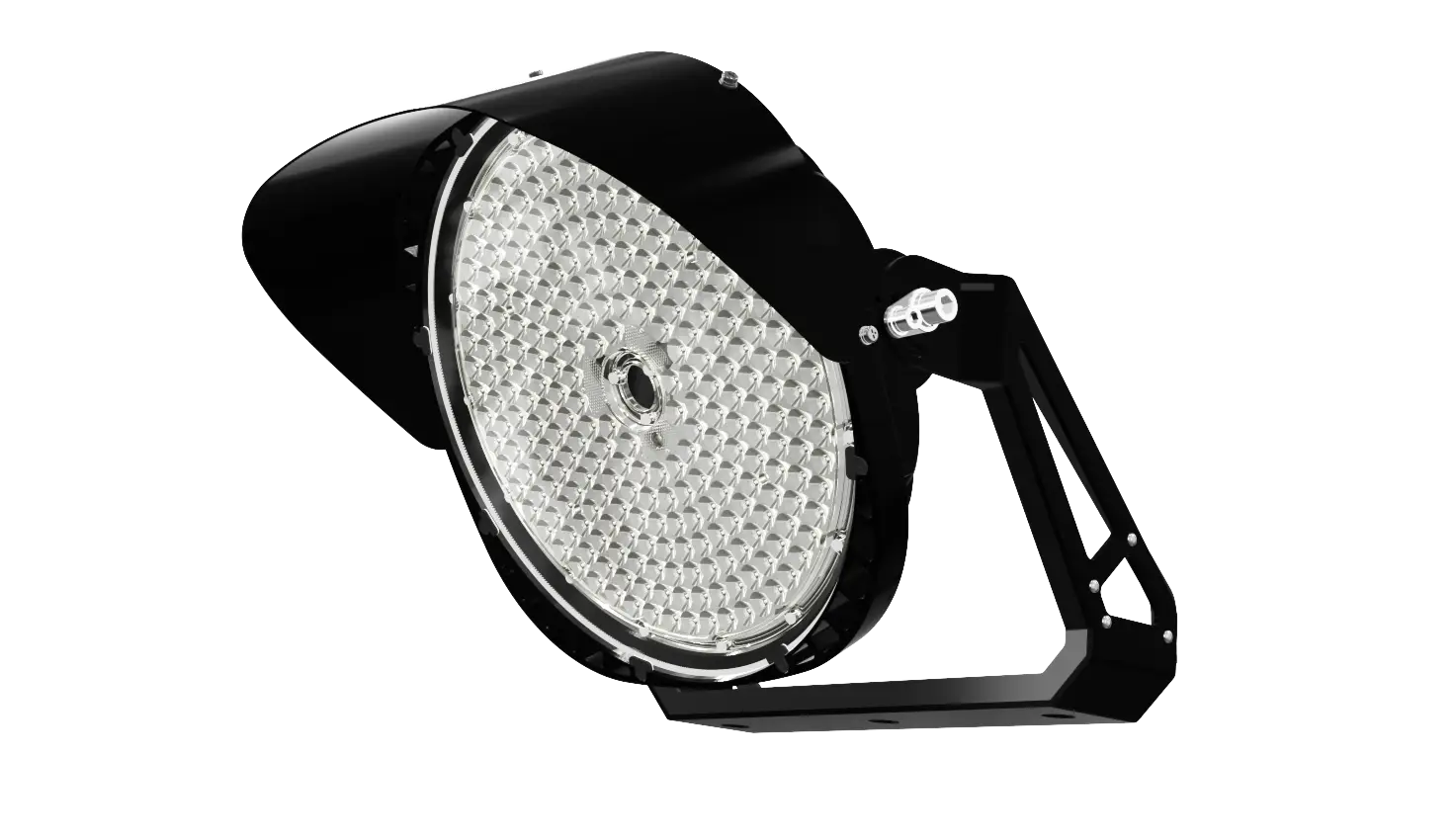Guía de iluminación LED para estadios: costos, beneficios y estándares
La iluminación es uno de los factores más críticos en las instalaciones deportivas modernas. Desde estadios profesionales hasta campos comunitarios, la calidad de la iluminación influye directamente tanto en el rendimiento de los jugadores como en la experiencia de los aficionados.
Las luminarias HID tradicionales, como las de haluro metálico y de sodio de alta presión, han sido el estándar durante mucho tiempo, pero sus limitaciones en eficiencia energética, precisión de color y costos de mantenimiento son cada vez más evidentes.
Aquí es donde entran en juego las luces LED para estadios. Ofrecen una iluminación más brillante y uniforme con menos deslumbramiento, a la vez que reducen los costos operativos a largo plazo. Ya sea para fútbol americano, béisbol, fútbol soccer o estadios multiusos, los LED son ahora la opción predilecta para los operadores de estadios de todo el mundo.

Directorio:
1. ¿Qué son las luces LED para estadios?
2. Beneficios clave del uso de luces LED para estadios
3. Estándares de iluminación LED para estadios
4. ¿Cómo la iluminación LED para estadios ayuda a ahorrar dinero?
5. Aplicaciones de las luces LED para estadios
6. ¿Cómo elegir las luces LED adecuadas para el estadio?
7. ¿Por qué elegir CeramicLite para iluminación LED de estadios?
1. ¿Qué son las luces LED para estadios?
Las luces LED para estadios (abreviatura de luces de diodo emisor de luz) son sistemas de iluminación especializados, diseñados específicamente para recintos deportivos. A diferencia de las luces tradicionales, que utilizan filamentos calefactores o descargas de gas para producir luz, las luces LED utilizan chips semiconductores para convertir la energía eléctrica directamente en luz visible. Esta diferencia tecnológica fundamental les otorga ventajas únicas adaptadas a las necesidades de los estadios, donde el brillo, la consistencia y la fiabilidad son fundamentales.
En esencia, las luces LED para estadios de alta calidad combinan tres componentes clave:
(1) Chips LED de alto brillo : generalmente hechos de materiales de nitruro de galio (GaN), estos chips emiten una luz intensa con una alta eficacia luminosa (normalmente 130-180 lúmenes por vatio, lm/W), lo que garantiza que incluso los estadios más grandes obtengan suficiente iluminación.
(2) Sistemas avanzados de disipación de calor : dado que los LED generan un calor mínimo (en comparación con las lámparas tradicionales), pero el exceso de calor puede acortar la vida útil, las luces LED de primer nivel para diseños de estadios incluyen disipadores de calor de aleación de aluminio o estructuras de disipación de calor de cerámica para mantener los chips fríos.
(3) Lentes ópticas de precisión : las lentes personalizables (con ángulos de haz que varían de 15° a 120°) dirigen la luz exactamente donde se necesita, ya sea cubriendo un campo de fútbol de 100 yardas o enfocándose en una cancha de baloncesto, evitando el desperdicio de luz y el resplandor.

2. Beneficios clave del uso de luces LED para estadios
Upgrading to LED stadium lights is not only about brighter fields—it's about transforming the entire sports experience while reducing operational costs. Here are the main advantages that make them the preferred choice for modern venues.
2.1 Energy Efficiency and Cost Reduction
Compared with traditional metal halide or HPS lamps, stadium lights LED consume up to 60–70% less electricity. This translates into massive yearly savings, especially for large stadiums running lights for hundreds of hours per season. The higher luminous efficacy (lumens per watt) ensures that less power is needed to achieve the same—or better—illumination levels.
2.2 Long Lifespan and Low Maintenance
While conventional lamps may last 3,000–10,000 hours, an LED stadium light can operate for 50,000 hours or more. Fewer replacements mean less downtime, reduced labor costs, and uninterrupted sporting schedules. For stadium operators, this long-term reliability directly improves ROI.
2.3 Better Broadcast Quality and Anti-Glare Design
Modern sports broadcasting demands flicker-free, high-quality lighting. LED stadium lights deliver stable, instant illumination with no warm-up delay, making slow-motion replays crisp and clear. Additionally, advanced optics minimize glare, enhancing player visibility and improving spectator comfort in both live and televised events.
2.4 Enhanced Flexibility and Control
Unlike traditional systems, stadium lights LED can integrate with smart control platforms. Operators can dim, program light shows, or switch lighting modes depending on the event—be it a football match, a concert, or a community gathering.
Having seen the advantages, the next step is to understand how LED lighting standards for stadiums define the right brightness, uniformity, and visual comfort for professional play.
3. LED Lighting Standards for Stadiums
When investing in LED stadium lights, it is crucial to follow international benchmarks to guarantee player safety, spectator comfort, and broadcast quality. Industry authorities like FIFA, FIBA, and CIE have established widely accepted LED lighting standards for stadiums that guide design and installation.

3.1 Recommended Illuminance Levels
Different sports require different brightness levels:
FIFA football stadiums: 500 lux for training fields, 2000 lux for HDTV broadcasting.
FIBA basketball arenas: minimum 750 lux for community play, 1500–2000 lux for professional matches.
CIE guidelines: recommend an illuminance level at least 3 times higher than the ambient light (E = 3 × environment lux).
These benchmarks ensure players see the ball clearly, referees make accurate calls, and cameras capture sharp images.
3.2 Uniformity of Light Distribution
It is not enough to achieve high brightness; the light must also be evenly spread. The uniformity ratio (U1 = Emin / Eavg) should reach at least 0.7 for professional arenas. Poor uniformity creates dark patches and glare spots, reducing performance and increasing eye strain.
3.3 Color Rendering Index (CRI)
High-quality stadium LED lights should have a CRI above 80, ideally 90+, to accurately display team colors and advertising banners. This is vital for both live spectators and TV audiences, ensuring the visual experience matches real-life colors.
3.4 Glare and UGR Limits
Glare control is a critical safety factor. CIE recommends a Unified Glare Rating (UGR) below 22 for stadium environments. Advanced lens designs in modern LED stadium lights minimize direct glare, giving athletes clearer vision and making matches more comfortable for the crowd.
With standards clarified, the next question most stadium owners ask is—beyond compliance—how do LED stadium lights save money over time? That's what we will explore in the next chapter.
4. How LED Stadium Light Helps Save Money?
Investing in LED lights stadium systems may seem costly at first, but the long-term savings far outweigh the initial expense. The financial benefits come from both direct and indirect cost reductions.
4.1 Lower Energy Consumption
Traditional metal halide and HPS lamps waste energy as heat. In contrast, LED stadium lights convert most power into visible light, cutting electricity bills by up to 70%. For large venues, this translates to tens of thousands of dollars in annual savings.
4.2 Reduced Maintenance Costs
With a lifespan exceeding 50,000 hours, LED stadium lights require far fewer replacements than halide lamps. This reduces the expense of new bulbs, labor for installation, and downtime caused by lighting failures.
4.3 Avoiding Event Disruptions
Unexpected lamp failures during games can cause delays or rescheduling, leading to lost revenue. LEDs provide instant, reliable illumination with no warm-up time, ensuring uninterrupted schedules and smoother operations.
4.4 Maximizing ROI Through Incentives
In many regions, switching to LED lights stadium solutions qualifies for government rebates or energy-efficiency subsidies. These programs accelerate payback time and improve return on investment.
Transition: Beyond cost savings, stadium owners also need to consider practical factors such as installation speed and project timelines. That's the focus of the next chapter.
5. Applications of LED Stadium Lights
The versatility of LED stadium lights makes them suitable for nearly every type of sports facility and event space. From professional arenas to community venues, their performance ensures both athletes and audiences get the best experience.

5.1 Football and Soccer Fields
LED football stadium lights are designed to deliver high lux levels, wide beam angles, and uniform coverage. They meet FIFA standards for international matches, ensuring clear visibility for players and broadcast cameras.
5.2 Basketball Arenas and Indoor Gyms
Basketball requires quick movement recognition and accurate color rendering. LED lighting ensures high CRI for better visibility of the ball, court markings, and team jerseys, improving both gameplay and spectator enjoyment.
5.3 Athletics Tracks and Multi-Sport Fields
Athletics venues need consistent lighting across large areas. LED floodlights offer precise beam control, minimizing shadows on tracks and field events like javelin, high jump, and discus.
5.4 Baseball Fields
Baseball demands vertical and horizontal illumination since the ball is small and fast-moving. LED stadium lights provide bright, uniform coverage for both the infield and outfield, reducing blind spots.
5.5 Stands, Exteriors, and Roof Installations
Beyond the playing field, LED stadium lights enhance audience comfort in stands, improve safety in parking areas, and create visual impact with roof-mounted displays or synchronized light shows during ceremonies.
Knowing where to apply lighting is only part of the decision. The next step is choosing the right specifications and models to ensure lasting performance.
6. How to Choose the Right Stadium LED Lights?
Selecting the right stadium LED lights requires more than just meeting brightness levels. Buyers need to evaluate technical parameters, durability, and suitability for their specific venue.
6.1 Core Technical Parameters
Luminous efficacy (lm/W): Determines energy efficiency. High-quality LED stadium lights deliver >130 lm/W, providing strong illumination with lower power use.
Illuminance levels: Match sport-specific standards (e.g., 2000 lux for professional football broadcasting).
Color Rendering Index (CRI): Look for CRI ≥ 80, ideally 90+, to ensure accurate colors on jerseys and advertisements.
Ingress Protection (IP rating): Outdoor installations require IP65+ to withstand rain, dust, and wind.
6.2 Types of Stadium Fixtures
Floodlights: Broad beams ideal for large football or baseball fields.
High-mast lights: Tall-pole systems for even coverage across big arenas.
Area lights: Designed for stands, concourses, and parking zones.
6.3 Certifications and After-Sales Support
When sourcing stadium LED lights, ensure compliance with UL, CE, or DLC certifications for safety and performance. A reliable supplier also provides warranties, spare parts, and quick technical support to keep venues running smoothly.
Once the right product is selected, the final step is to choose a trusted supplier with proven expertise and successful case studies.
7. Why Choose CeramicLite for LED Stadium Lights?
When it comes to high-performance LED stadium lights, choosing the right supplier is just as important as selecting the right fixture. Ceramiclite brings together advanced technology, durable engineering, and long-term reliability to deliver solutions that meet the demanding needs of modern sports venues.
7.1 Advanced Ceramic LED Technology
At the core of every Ceramiclite luminaire is its proprietary FTC (transparent ceramic phosphor) material. Unlike conventional packaging, FTC offers superior thermal stability, excellent lumen maintenance, and resistance to sulfur, ammonia, acids, and alkalis. This means brighter, more reliable lighting even under extreme conditions.
7.2 Products Designed for Performance
Ceramiclite's sports lighting range includes the SL03 and SL04 stadium lights:
Sports Light SL03: Lightweight, modular, and wind-resistant, with CRI/TLCI 90 and DALI 2.0 smart control. Ideal for football fields, baseball arenas, and community sports facilities.
Sports Light SL04: Engineered for professional arenas with opto-electrical separation, multi-protocol dimming (0–10V, DALI, DMX), advanced glare control, and seamless HID replacement options.
Both models are IP66/IK08 rated, equipped with 20KV surge protection, and tested to last over 100,000 hours (L80B10).
7.3 Durability and Safety Assured
Ceramiclite products are designed for harsh environments. Features such as C4 anti-corrosion, bird-proof cabling, and dual-layer lens protection ensure consistent performance in outdoor stadiums, coastal regions, and high-humidity areas. International certifications like UL and CE guarantee compliance with global safety standards.
7.4 Long-Term Value
Beyond technology, Ceramiclite offers extended warranties of up to 10 years, reducing ownership costs for stadium operators. With intelligent lighting controls, venues can optimize energy use and qualify for sustainability incentives, maximizing return on investment.
With a trusted partner like Ceramiclite, stadium operators can confidently move forward, knowing they have both cutting-edge lighting and dependable long-term support. Next, let's wrap up with the key reasons why LED stadium lights are the ultimate choice for modern sports facilities.
8. Conclusion
LED Stadium Lights are more than just a replacement for traditional lamps—they deliver significant energy savings, long-term cost reduction, superior visual experience, and a practical installation cycle that fits modern stadium needs. By meeting international standards and ensuring player and spectator comfort, they have become the top choice for sports facilities worldwide.
If you are planning a new project or upgrading existing systems, now is the time to switch. Contact us today to get a tailored solution and a free quote for LED Stadium Lights.
9. FAQs
Q1: How long do LED stadium lights last?
La mayoría de las luces LED para estadios ofrecen una vida útil de 50.000 a 100.000 horas, lo que minimiza los costos de reemplazo en comparación con las lámparas tradicionales.
P2: ¿Las luces LED para estadios de fútbol son adecuadas para el clima exterior?
Sí. Los accesorios de alta calidad vienen con protección IP65-IP67, lo que garantiza resistencia a la lluvia, el polvo y los cambios de temperatura.
P3: ¿Pueden las luces LED del estadio reducir el resplandor para los jugadores y los fanáticos?
Las luces de estadio modernas siguen los estándares antideslumbrantes de UGR y adoptan ópticas precisas, lo que garantiza comodidad y seguridad.
P4: ¿Qué tan eficientes energéticamente son en comparación con las luces tradicionales?
La iluminación LED de los estadios consume entre un 50 y un 70 % menos de energía y ofrece una mayor producción de lúmenes por vatio.
P5: ¿Cuánto tiempo se tarda en instalar la iluminación LED en un estadio?
Por lo general, unos días o semanas, dependiendo del tamaño del estadio, la altura de los postes y la complejidad del cableado.
P6: ¿Las luces LED para estadios cumplen con los estándares internacionales?
Sí, las mejores soluciones cumplen con los estándares de iluminación FIFA, FIBA y CIE, que cubren brillo, uniformidad y reproducción del color.
Producto relacionado
_thumb.jpg)

